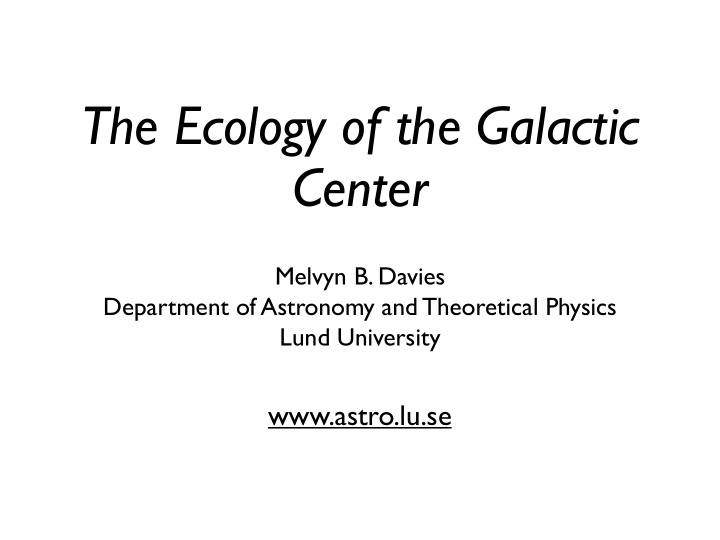



The Ecology of the Galactic Center Melvyn B. Davies Department of Astronomy and Theoretical Physics Lund University www.astro.lu.se
What does the absence of red giants tell us about what occurs in galactic nuclei? Melvyn B. Davies Department of Astronomy and Theoretical Physics Lund University www.astro.lu.se
Red giants observed to have a flat surface density (Buchholz et al. 2009)
Observed red-giant distribution is a surprise We would expect to see a cusp of red-giant stars as predicted by Bahcall & Wolf (1976) as the SMBH dominates within about 1pc. Instead the distribution is flat within 5 arcsec (0.2pc). Something has happened to either remove the RGs (we don’t see) in the middle or to dynamically heat the stellar cluster (e.g. Antonino et al. 2012).
Observations are consistent with RG destruction r_kill = 0.2pc But density could have a cored profile. See also talks by Fabio & Rainer
Going to focus here on possible ways to remove stars which would appear today as RGs
Which red-giant stars are missing? 10 1 M ⊙ 12 m K 14 16 0 10 8 2 × 10 8 3 × 10 8 ( t − 12 . 15 Gyr) / yr Most red giants are small (Pfuhl et al. 2011)
Galactic center is a dense environment (Schödel et al. 2014)
RG-BH collisions: RG-BH collision with v ∞ =800kms -1 ,R min =10R ⊙ , 1M ⊙ giant, 10M ⊙ BH (Dale et al. 2009) However: RG-MS/NS/WD leave a RG (because 1=2)
Possible ways to remove red-giant population: 1) RG stellar collisions: RG-anything else, RG-BH (clobber giant) 2) MS stellar collisions: MS-MS (change mass distribution), MS-CO 3) Star-disc interactions: strip RG as it ascends giant branch 4) Illumination from active SMBH: illumination affects stellar evolution 5) Encounters between single stars and binaries Dynamical ways which might remove red-giant population 6) Stellar binaries affected by Kozai effect (see Smadar’s talk) 7) Make NSC first then form SMBH 8) Age and/or metallicity segregation of infalling clusters 9) Mass segregation: BHs sink, RGs pushed out I will focus on MS-MS collisions . KEY IDEA: 1 + 1 = 2 ... meaning that low-mass population is depleted as more massive stars evolve away in a few Gyr.
Stellar collision timescale 1 = 16 √ π n σ r 2 ? (1 + Θ ) t coll ✓ m ◆ 2 ◆ ✓ R � ◆ ✓ 100km / s where Θ = 9 . 54 r ? M � σ (Binney & Tremaine 2008) Consider a very simple model: M bh = 4 × 10 6 M � m = 1M � M ? = 2 × 10 5 M � r ? = 1R � t coll ' 12 Gyr R = 0 . 2 pc
Consider how formation history of NSC and SMBH may increase MS-MS merger rate in the past
Nuclear Stellar Clusters M33 contains no SMBH (Neumayer & Walcher 2012)
KEY IDEA for M33-likes: Above a critical velocity dispersion (around 40 km/s), SMBHs may form in relaxed stellar systems. This is because primordial binaries cannot support the cluster against core collapse. (Miller & Davies 2012) ...So our Galactic center may have contained only a NSC which then produced a SMBH via core collapse meaning the NSC was denser in the past. ...Or gas inflow could lead to a contraction of the central regions of the cluster leading to collisions and SMBH formation. (Davies et al. 2011) WET vs. DRY growth of NSCs
Collision timescale could have been smaller (in the past) Bottom line: MS-MS mergers occur interestingly often for a more massive cluster 1 + 1 = 2: So we don’t have central RGs today (Davies et al., in prep.)
Some low-metallicity stars seen in GC Padua isochrones [M/H] = 0 [M/H] = -1 [M/H] = -2 (data from Do et al. 2015; also see Tuan Do’s talk )
Some low-metallicity stars seen in GC (data from Do et al. 2015; also see Tuan Do’s talk )
Summary: 1) Missing RGs in our own galaxy could be telling us about the history of the galactic center. 2) Many RGs have collisions but most collisions do not remove RGs. Only RG-BH collisions are useful but they are too rare. RG-X made G1/G2? 3) MS-MS collisions could remove RG population today but collision rate today is too low. 4) If NSC formed before SMBH then it was denser in the past so easier to merge stars. 5) NSC construction history could mean that inner stars are older (and more metal poor?)
Recommend
More recommend